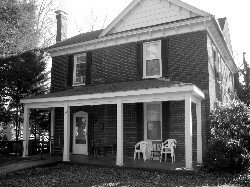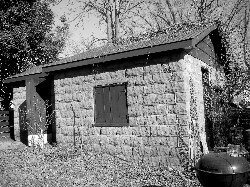REAL ESTATE- ON THE BLOCK- Good management: Farmhouse offers history and potential
ADDRESS: 1100 Locust Avenue
NEIGHBORHOOD: Locust Grove
ASKING: $459,000
2006 CITY ASSESSMENT: $397,700
YEAR BUILT: 1920
SIZE: 2,722 fin. sq. ft.
LAND: 0.38 acres
CURB APPEAL: 7 out of 10
LISTED BY: John Sweet, Roy Wheeler Realty, 951-5196
Everyone complains these days about how radically the city and county have changed over the last decade or so, and there's no question the pace of development (and the concomitant paving ) has been fierce and demoralizing. But although it might have been slower, Charlottesville's gradual metamorphosis from a small rural town to a city must have been just as startling for residents in the early part of the last century.
We were reminded of that fact when we toured this house at the corner of Locust Avenue and Smith Street. Neighborhood lore has it that the place was originally built to house the farm manager of Locust Grove, the alpha mansion at 810 Locust Avenue (at the corner of Hazel), almost three-quarters of a mile away. Thinking of green cow-pocked fields covering all the land that's now a dense, populated neighborhood (and the Rt. 250 Bypass) is more than demoralizing, but of course it's the price of progress– without which none of us would be here, since there undoubtedly weren't enough chores on the Locust Grove spread to employ us all.
That little reverie is just part of the history lesson the house provides. Out back, a funky concrete-veneer building is reputed to have been the "milk house" where the farm's dairy products were sold– a theory bolstered by the agent's surmise that an unusual sprocket/gear gizmo in the floor might be the remains of a long-lost churn.
The main house was built in two stages: the original two-over-two right section with a later addition clearly evident on the left. A plain, four-columned porch with a floor of slate squares is representative of the rest of the house: unprepossessing and serviceable, with a hint of class. Inside, two average-size rooms (in the original, right side of the house) and a beautiful paneled stairway (on the left) flank a wide entrance hall that leads straight back to a room of indeterminate use and the added-on kitchen, both down a few steps from the original section.
The two front rooms each have fireplaces, and it's easy to imagine a new owner opening the walls surrounding them to create a large room with center double fireplace. As is common in houses of the era, pine floors and high ceilings mark this part of the house.
The kitchen addition on the back is marginal, with a low ceiling and linoleum floors, and would probably be the first demo undertaken by a new owner. However, a large screened-in porch off the kitchen provides lots of possibilities for an imaginative and expansive re-do. A door from the mysterious middle room leads to a pretty side porch facing Smith Street, while a full bath on the other side has a window to the small side yard (now blocked by ugly stairs to the upstairs apartment, easily expendable).
The upstairs is currently outfitted as a separate apartment, with full kitchen and bath, providing an appealing option (rental income) for someone who wants to live in a historic house in this desirable location, but who might not have the money on hand to convert the place back to a single-family showplace. In addition to the kitchen, upstairs are four bedrooms, one with an existing fireplace and one, boarded up, that could be another fireplace making a matching pair to the two below.
The view to the north from this level is of pretty mountains, somehow bypassing the power plant near the lower end of Locust Avenue that blights views from other windows in the house (and that undoubtedly does so for all the surrounding properties, too).
The house is owned by the ARC of the Piedmont which uses it as a residence for its clients. The agent reports that a fire several years ago did enough damage to warrant a $47,000 renovation, but apart from new vinyl windows throughout (don't weep, see below), the repairs fixed what had to be fixed without compromising the integrity of the original.
For that foresightedness, the administrators of the ARC are to be congratulated. They have preserved the spirit and essence of what could be an impressive single-family residence– even though they felt the need to replace the original windows with energy-efficient, "tilt-sash, insulated" models (the very words are ugh-worthy), they thoughtfully stashed all the originals in the milk house out back, so a new buyer has the option of returning the place to its former self– if the windows can be made compatible with 21st-century comfort demands, of course.
Speaking of comfort, there's no central AC in the house, and the heat is electric baseboard. Again, these are elements a new owner could live with while squirreling away enough cash to undertake a thorough restoration. When (and if) that happens, this venerable old house has the potential to once again be the cream of the crop down here in Locust Grove's back forty.



Photos by Rosalind Warfield-Brown
#